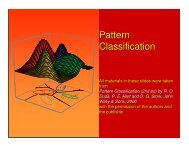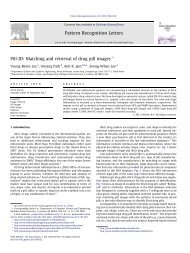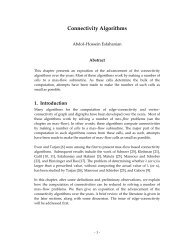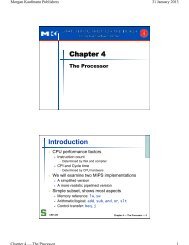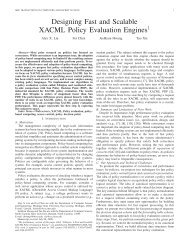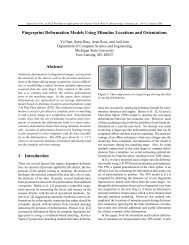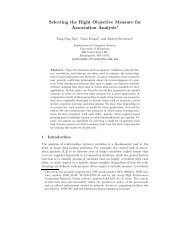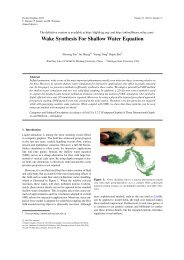Latent Fingerprint Indexing - Computer Science and Engineering
Latent Fingerprint Indexing - Computer Science and Engineering
Latent Fingerprint Indexing - Computer Science and Engineering
Create successful ePaper yourself
Turn your PDF publications into a flip-book with our unique Google optimized e-Paper software.
Table 2. Increase in hit rate (HR) at a fixed penetration rate (PR)(20%) as we incrementally add features for indexing (from left toright), where CTrip is constrained triplets, OFDesc is orientationfield descriptor indexing, SP is singular points, RP is ridge period.CTrip OFDesc MCC SP RP74.0% 81.8% 84.5% 87.6% 90.3%ing. For indexing of reference prints, the state of the artindexing methods [5] already report very high hit rate atvery low penetration rate. For example, the indexing performanceof MCC applied on NIST SD4 (the 2,000 secondimpressions are searched against the 2,000 first impressions<strong>and</strong> 10,000 reference prints from the Michigan State Policedatabase) shows a hit rate of 97.8% at 5% penetration rate.Including additional features do not further improve the indexingperformance in this case.In order to further evaluate the performance of the proposedindexing algorithm, we also analyzed the influenceof the filtering on the latent matching performance. For thispurpose, two fingerprint matchers were used (one in-housematcher [17] <strong>and</strong> one COTS matcher, referred as Matcher1 <strong>and</strong> Matcher 2, respectively). The input to the matchersconsisted of manually marked minutiae in the latents <strong>and</strong>automatically extracted minutiae in the rolled prints, whichis the same set of minutiae that was used in the indexingexperiments. For this experiment, for computational efficiency,we used a smaller background database of 27,258rolled prints (258 from NIST SD27 <strong>and</strong> 27K from NISTSD14). For both the matchers, the overall latent matchingperformance on NIST SD27 before <strong>and</strong> after filtering out80% of the background database (penetration rate of 20%)is maintained (the total computation time for the search isreduced by a factor of 5), as shown in Fig. 5. This is dueto the fact that although the indexing is not perfect, most ofthe errors made by our indexing scheme are also errors inthe latent matching stage as well.Identification Rate (%)7570656055Matcher 1 before filteringMatcher 1 after filtering50Matcher 2 before filteringMatcher 2 after filtering0 20 40 60 80 100RankFigure 5. <strong>Latent</strong> matching performance before <strong>and</strong> after applyingthe proposed indexing to filter out 80% of the backgrounddatabase (20% penetration rate). Note that the overall matchingperformance is maintained after filtering.Two latents <strong>and</strong> their true mates are shown in Fig. 6. Inthe first case (Fig. 6(a)), the retrieval rank of the true matewas improved from 3 to 1 after the filtering was applieddue to the exclusion of the two rolled prints ranked first <strong>and</strong>second in the matching stage. In the second case (Fig. 6(b)),the true mate was not retrieved among the top-100 retrievalsat a 20% penetration rate. This was due to missing minutiae<strong>and</strong> limited number of triplets in the latent, which made thetrue mate retrieval rank for MCC <strong>and</strong> triplets low, althoughthe true mate retrieval rank for orientation field descriptorwas very good. Furthermore, the retrieval rank of the truemate before filtering was 543, which means that it was notin the top-100 c<strong>and</strong>idate list before the filtering.(a)(b)Figure 6. Examples of latents <strong>and</strong> their true mates in which thefiltering applied at 20% penetration rate (a) improved <strong>and</strong> (b) degradedthe true mate retrieval rank (rank 3 to rank 1, <strong>and</strong> rank 543to exclusion, respectively).5.3. Implementation DetailsThe triplet indexing algorithm, singular point <strong>and</strong> ridgeperiod estimation modules are implemented in Matlab;MCC SDK (implemented in C#) is provided by the authorsof [5] <strong>and</strong> can be downloaded from their webpage 1 ;theorientation field descriptor-based indexing algorithm is implementedin C++. MCC indexing timing was obtained on aPC (Intel(R) Core(TM)2 Quad CPU Q9650 3.00GHz, 3GBmemory), <strong>and</strong> the timings for all the other modules wereobtained on a server with 48 cores (AMD Opteron(tm) Processor6176, 2.3GHz, 193GB memory); no parallel computingresource was used, thus only one core was used whenmeasuring the computation time.Since the modules are all independent <strong>and</strong> can be run inparallel, we estimate the indexing efficiency based on the1 http://biolab.csr.unibo.it/




